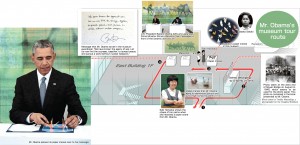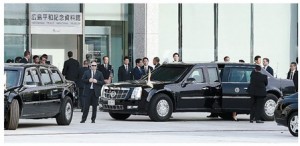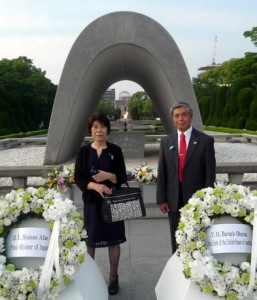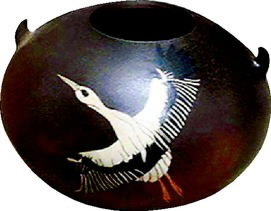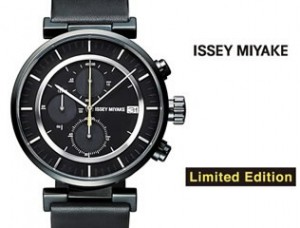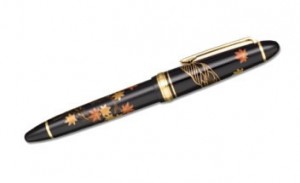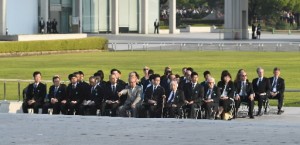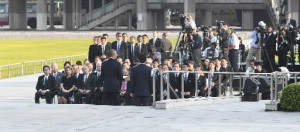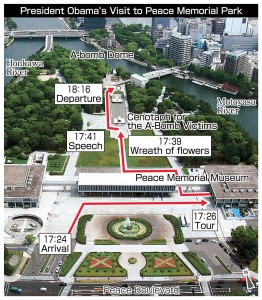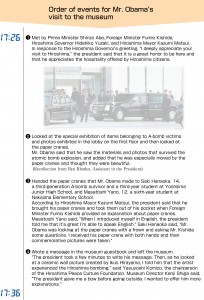Summer of President Obama’s visit to Hiroshima: 52 significant minutes, Introduction
Jul. 20, 2016
Introduction: Recounting the president’s visit to the A-bombed city
by Michiko Tanaka, Hidetoshi Arioka, Kyosuke Mizukawa, and Yumie Kubo, Staff Writers
On May 27, U.S. President Barack Obama made a historic visit to Hiroshima. Under tight security, unprecedented for the city, a ceremony to welcome the president was held at the Peace Memorial Park in Naka Ward and attended by around 100 people. Only those involved in the event, as well as a small number of invited guests that included 10 atomic bomb survivors, were permitted to enter the venue.
What did President Obama see in the Peace Memorial Museum and what was his reaction? What did the A-bomb survivors and young people think and feel as they quietly listened to the president’s “Hiroshima Speech”? This article recounts President Obama’s “52-minute visit” to the Hiroshima Peace Memorial Park.
Yorie Kano and Toshiharu Kano, residents of the U.S.: President Obama should have spent more time with A-bomb survivors
Yorie Kano, 73, a resident of California, and her brother Toshiharu Kano, 70, a resident of Utah, are both A-bomb survivors now living in the United States. They attended the ceremony at the invitation of the U.S. government. Yorie’s last visit to Hiroshima was 41 years ago and Toshiharu was last here when he was four years old. Reflecting on the fact that Mr. Obama met and spoke with only a few A-bomb survivors for just a short period of time, they said that the president should have heard more from the survivors in attendance and should have reached out to feel the warmth of their hands.
Yorie and Toshiharu are descendants of Japanese immigrants to the United States. Their parents were born in Hawaii, but the family returned to Hiroshima before the outbreak of the Pacific War. On August 6, 1945, Yorie and her mother were at home in Nishihakushima-cho (now part of Naka Ward). Yorie, the family’s eldest daughter, was two years old, and her mother was pregnant with Toshiharu, the second son. Yorie and her mother became trapped under the wreckage of their home, flattened by the A-bomb blast, but they somehow managed to crawl out with the eldest son, a year old at the time. That son, however, passed away three months later.
Their father also experienced the bombing while on a nearby street. The Kano family ended up heading back to the United States in 1961, but the physical and mental scars left by the atomic bombing still linger to this day. In 2015, Toshiharu published a book about his life. In it, he describes suffering from a variety of health problems and uses his experience to convey the horror and tragedy of nuclear attack.
In one of the phrases from President Obama’s speech, that “We’re not bound by our genetic code to repeat the mistakes of the past,” Yorie and Toshiharu found hope. They said, “The world must stop justifying the use of nuclear weapons. All weapons of mass destruction must be eliminated from the earth.”
Sunao Tsuboi, 91, resident of Nishi Ward, Hiroshima: President Obama said “Thank you”
Sunao Tsuboi experienced the atomic bombing about 1.2 kilometers from the hypocenter when he was a third-year student at the Hiroshima Technical Institute (now Hiroshima University). He spoke with President Obama for about two minutes after the president’s speech.
I think it was good that President Obama visited Hiroshima. Although I don’t want him to think he has fully understood the consequences of the atomic bombing from just a 10-minute visit to the museum, the fact that a sitting president of the nation that dropped the atomic bomb spoke with A-bomb survivors is an important step.
I mainly talked about three things while holding his hands. First, I expressed my gratitude for his visit to Hiroshima. Second, I said to him, “The next step is important. Please come to Hiroshima again to learn more about what happened here on and after August 6, 1945, and talk with the citizens of Hiroshima including the A-bomb survivors.” President Obama then gripped my hand more firmly and smiled. Lastly, I said, “Let’s work together to eliminate all nuclear weapons.” “Thank you” is all that he said in response.
Because I was severely burned by the atomic bomb, I actually hold a deep-seated hatred for the United States. However, I did feel warmth in President Obama as he appealed in his speech for war to be abolished for the benefit of all humankind. There isn’t much time left for most of the A-bomb survivors, so I want to view the president’s visit as an important opportunity to advance the abolition of nuclear arms. Otherwise, I’ll lose heart and hope for achieving the goal of a world without nuclear weapons. So I plan to continue making efforts for this goal with other A-bomb survivors.
Shigeaki Mori, 79, resident of Nishi Ward, Hiroshima: President Obama’s warm hands and friendly eyes
Shigeaki Mori experienced the atomic bombing when he was in the third grade at Koi National School. A local historian, he researched the American prisoners of war who lost their lives in the atomic bombing. After his speech, President Obama spoke with him and embraced him.
I was very glad that the U.S. government conveyed appreciation for my research into the American soldiers who died in Hiroshima and that I was able to sit in the front row at the ceremony. But more than that, I was delighted when President Obama mentioned in his speech that he came to Hiroshima to mourn the soldiers who were killed by the atomic bomb. When the president approached me, I was so nervous my mind went blank, but I said to him, “The 12 dead American soldiers are watching down on us from heaven.” At that point, the faces of the family members of the soldiers and those of U.S. veterans who have mourned the dead soldiers since the Hiroshima bombing suddenly came to me, and I was overwhelmed with emotion.
As I watched the president’s serious eyes during his speech, it was clear to me that he has given thought to the goal of a world without war. His hands were so warm and his eyes were so friendly.
Terumi Tanaka, 84, resident of Niiza City, Saitama: President Obama didn’t face the consequences of the A-bomb
Terumi Tanaka experienced the atomic bombing of Nagasaki while at his home, located 3.2 kilometers from the hypocenter. At the time, he was a first-year student at the former Nagasaki Junior High School.
I had hoped President Obama would do three things: etch the museum’s exhibits into his memory; meet with several A-bomb survivors and listen to their voices; and comfort the souls of the A-bomb victims. Instead, he rushed through the A-bombed city and didn’t squarely face the tremendous damage caused by the atomic bomb.
A visit like that has no value. After first hearing the president’s speech, I thought it was worth our appreciation. But when I reread it later, I didn’t think so. And this is because his speech included no concrete steps for reducing nuclear arms. Also, I can’t accept the sort of language from his speech that says “death fell from the sky.” By expressing the atomic bombing of Hiroshima in this way, President Obama avoided taking U.S. responsibility for the atomic bombing of Japan. Most A-bomb survivors want to see the U.S. government’s apology for the atomic bombings reflected in what the United States does to advance the abolition of nuclear weapons. To realize this goal, I’d like President Obama and the U.S. government to make their best effort for nuclear abolition. I also hope that Mr. Obama will visit Hiroshima again and Nagasaki, too.
Museum director Kenji Shiga: President Obama looked closely at Sadako’s paper cranes
It was the first time that a sitting American president visited the Hiroshima Peace Memorial Museum. The Chugoku Shimbun spoke with Kenji Shiga, the museum direction, about President Obama’s reaction to visiting the museum on May 27.
We had been told, in advance, by Japan’s Foreign Ministry that it would be very difficult for President Obama to devote 30 minutes to tour the museum, so we placed the exhibits which clearly convey the catastrophic consequences of the atomic bombing on the first floor of the museum’s East Building in order for the president to see them within the limited amount of time.
What we exhibited were the paper cranes folded by Sadako Sasaki (a girl who was exposed to the atomic bomb at the age of two and died of radiation-induced leukemia 10 years later), the personal belongings of A-bomb victims, and some photo panels detailing the consequences of the atomic bombing. Because we were also told by the Foreign Ministry that the story of Sadako is widely known in the United States and that President Obama is also very interested in it, we placed some 20 paper cranes (approximately one centimeter square), which are usually kept in the museum’s storage room, on a display table and removed the acrylic case from the cranes just before the president’s visit to the museum. Mr. Obama bent down toward the cranes so he could look at them closely and carefully.
In particular, I’d like visitors to the museum to get a sense of the regret and chagrin felt by the people whose belongings are displayed at the museum. The same hope goes for Mr. Obama as he looked at Sadako’s paper cranes. From her courage and tenacity in folding paper cranes, and from her regrettable death, I hope that Mr. Obama could comprehend the tremendous violence caused by the atomic bomb on that day. In his speech after visiting the museum, I wanted him to talk about what he saw there and how he felt about seeing these items.
In addition to Sadako’s paper cranes, we displayed some belongings of A-bomb victims that have been held in the museum’s storage room and some photos and panels that convey the damage and destruction caused by the atomic bomb, though government policy prevents us from divulging details of this information. However, I would like to respond fully to the public’s interest in Mr. Obama’s visit to the museum. For the future release of information related to his visit, the museum will maintain a record of his presence here on May 27.
Commemorative gifts connected to Hiroshima
Hiroshima Prefecture, Hiroshima City, and the Peace Memorial Museum presented President Obama with commemorative gifts connected to Hiroshima.
Hiroshima Prefecture presented a porcelain flower vase made by Masayuki Imai, 85, an honored porcelain artist who is originally from the city of Takehara but is now a resident of Kyoto. A pair of storks symbolizing peace are engraved on the surface of the vase. According to Hiroshima Prefecture, Mr. Imai was so moved by the speech President Obama made in Prague that he sent him a porcelain picture frame six years ago, and thus Hiroshima Prefecture asked him to create a new gift to mark Mr. Obama’s visit to Hiroshima.
Hiroshima City presented two items. One was a wrist watch designed by Issey Miyake, a designer and A-bomb survivor from Higashi Ward. The watch is the same model as those presented to the participants of the Foreign Ministers’ Meeting held in Hiroshima this past April. The city also presented Mr. Obama with a fountain pen, inscribed with maple leaves, produced by the Sailor Pen Company of Kure City. Both products are valued at about 40,000 yen.
The Peace Memorial Museum presented Mr. Obama with items that convey the devastation caused by the atomic bomb, which could be viewed by the president after his return home. These include include two pictorial record books: The Spirit of Hiroshima, which contains photos of A-bomb artifacts, such as belongings of the victims, and photos that show the destruction and the lives of the survivors in the aftermath of the bombing; and A-bomb Drawings by Survivors, consisting of 1246 drawings made by A-bomb survivors which depict the survivors’ experiences on that day and the scenes that were seared into their minds. The museum also presented a framed picture of a lunch box which belonged to a student who was killed by the atomic bomb while helping to tear down houses to create a fire lane. The photo was taken by photographer Hiromi Tsuchida.
Impressions of young people from Hiroshima and Nagasaki
Nakajima Elementary School (Naka Ward, Hiroshima)
Hinata Ogame, 12
My great grandmother is an A-bomb survivor and has a keloid scar on her arm caused by the atomic bomb. Watching President Obama deliver his speech while making eye contact with the A-bomb survivors made me happy.
Waka Takemoto, 11
The phrase “death fell from the sky” in the president’s speech made me think of the destruction to the area where the Peace Memorial Park now lies, before the atomic bomb was dropped.
Takumi Fukuoka, 11
My image of the United States is that it often gets involved in wars, but the serious expression on Mr. Obama’s face gave me the impression he’s working hard to help create a peaceful world.
Yuma Kameda, 11
It seemed Mr. Obama studied up on the atomic bombing. Like him, I’m going to study and find out what I should do to help eliminate nuclear weapons.
Yoshijima Junior High School (Naka Ward, Hiroshima)
Reo Yoshihara, 14
The president looked at us while making his speech. I think we should convey the voices of the A-bomb survivors into the future.
Taku Morioka, 14
I saw the president smile after talking with an A-bomb survivor and it seemed like they had a good conversation. This made me feel relieved.
Megu Shimomura, 14
My grandmother is an A-bomb survivor. I was moved when the president said in his speech, “Those who died, they’re like us.”
Rina Akahata, 14
The president’s speech inspired me to study the history of the war and the atomic bombing and share what I learn with people from other countries.
Nagasaki
Yukari Nakahara, 22
I thought the president’s speech was beautiful, but I was disappointed to hear that the nuclear weapon states won’t give up their nuclear weapons. Like the president said, war destroys people’s daily lives.
Imari Yasuno, 16
Although I was disappointed that the president’s speech didn’t include any concrete steps for advancing nuclear abolition, I think Mr. Obama helped make the world aware of the existence of the A-bomb survivors.
Noa Moriuchi, 14
When Mr. Obama made eye contact with me, he took my hand and shook it. I think I was able to convey to the president my feeling that war is wrong. I hope he will visit Nagasaki to talk to the A-bomb survivors there.
(Originally published on July 20, 2016)
by Michiko Tanaka, Hidetoshi Arioka, Kyosuke Mizukawa, and Yumie Kubo, Staff Writers
On May 27, U.S. President Barack Obama made a historic visit to Hiroshima. Under tight security, unprecedented for the city, a ceremony to welcome the president was held at the Peace Memorial Park in Naka Ward and attended by around 100 people. Only those involved in the event, as well as a small number of invited guests that included 10 atomic bomb survivors, were permitted to enter the venue.
What did President Obama see in the Peace Memorial Museum and what was his reaction? What did the A-bomb survivors and young people think and feel as they quietly listened to the president’s “Hiroshima Speech”? This article recounts President Obama’s “52-minute visit” to the Hiroshima Peace Memorial Park.
Yorie Kano and Toshiharu Kano, residents of the U.S.: President Obama should have spent more time with A-bomb survivors
Yorie Kano, 73, a resident of California, and her brother Toshiharu Kano, 70, a resident of Utah, are both A-bomb survivors now living in the United States. They attended the ceremony at the invitation of the U.S. government. Yorie’s last visit to Hiroshima was 41 years ago and Toshiharu was last here when he was four years old. Reflecting on the fact that Mr. Obama met and spoke with only a few A-bomb survivors for just a short period of time, they said that the president should have heard more from the survivors in attendance and should have reached out to feel the warmth of their hands.
Yorie and Toshiharu are descendants of Japanese immigrants to the United States. Their parents were born in Hawaii, but the family returned to Hiroshima before the outbreak of the Pacific War. On August 6, 1945, Yorie and her mother were at home in Nishihakushima-cho (now part of Naka Ward). Yorie, the family’s eldest daughter, was two years old, and her mother was pregnant with Toshiharu, the second son. Yorie and her mother became trapped under the wreckage of their home, flattened by the A-bomb blast, but they somehow managed to crawl out with the eldest son, a year old at the time. That son, however, passed away three months later.
Their father also experienced the bombing while on a nearby street. The Kano family ended up heading back to the United States in 1961, but the physical and mental scars left by the atomic bombing still linger to this day. In 2015, Toshiharu published a book about his life. In it, he describes suffering from a variety of health problems and uses his experience to convey the horror and tragedy of nuclear attack.
In one of the phrases from President Obama’s speech, that “We’re not bound by our genetic code to repeat the mistakes of the past,” Yorie and Toshiharu found hope. They said, “The world must stop justifying the use of nuclear weapons. All weapons of mass destruction must be eliminated from the earth.”
Sunao Tsuboi, 91, resident of Nishi Ward, Hiroshima: President Obama said “Thank you”
Sunao Tsuboi experienced the atomic bombing about 1.2 kilometers from the hypocenter when he was a third-year student at the Hiroshima Technical Institute (now Hiroshima University). He spoke with President Obama for about two minutes after the president’s speech.
I think it was good that President Obama visited Hiroshima. Although I don’t want him to think he has fully understood the consequences of the atomic bombing from just a 10-minute visit to the museum, the fact that a sitting president of the nation that dropped the atomic bomb spoke with A-bomb survivors is an important step.
I mainly talked about three things while holding his hands. First, I expressed my gratitude for his visit to Hiroshima. Second, I said to him, “The next step is important. Please come to Hiroshima again to learn more about what happened here on and after August 6, 1945, and talk with the citizens of Hiroshima including the A-bomb survivors.” President Obama then gripped my hand more firmly and smiled. Lastly, I said, “Let’s work together to eliminate all nuclear weapons.” “Thank you” is all that he said in response.
Because I was severely burned by the atomic bomb, I actually hold a deep-seated hatred for the United States. However, I did feel warmth in President Obama as he appealed in his speech for war to be abolished for the benefit of all humankind. There isn’t much time left for most of the A-bomb survivors, so I want to view the president’s visit as an important opportunity to advance the abolition of nuclear arms. Otherwise, I’ll lose heart and hope for achieving the goal of a world without nuclear weapons. So I plan to continue making efforts for this goal with other A-bomb survivors.
Shigeaki Mori, 79, resident of Nishi Ward, Hiroshima: President Obama’s warm hands and friendly eyes
Shigeaki Mori experienced the atomic bombing when he was in the third grade at Koi National School. A local historian, he researched the American prisoners of war who lost their lives in the atomic bombing. After his speech, President Obama spoke with him and embraced him.
I was very glad that the U.S. government conveyed appreciation for my research into the American soldiers who died in Hiroshima and that I was able to sit in the front row at the ceremony. But more than that, I was delighted when President Obama mentioned in his speech that he came to Hiroshima to mourn the soldiers who were killed by the atomic bomb. When the president approached me, I was so nervous my mind went blank, but I said to him, “The 12 dead American soldiers are watching down on us from heaven.” At that point, the faces of the family members of the soldiers and those of U.S. veterans who have mourned the dead soldiers since the Hiroshima bombing suddenly came to me, and I was overwhelmed with emotion.
As I watched the president’s serious eyes during his speech, it was clear to me that he has given thought to the goal of a world without war. His hands were so warm and his eyes were so friendly.
Terumi Tanaka, 84, resident of Niiza City, Saitama: President Obama didn’t face the consequences of the A-bomb
Terumi Tanaka experienced the atomic bombing of Nagasaki while at his home, located 3.2 kilometers from the hypocenter. At the time, he was a first-year student at the former Nagasaki Junior High School.
I had hoped President Obama would do three things: etch the museum’s exhibits into his memory; meet with several A-bomb survivors and listen to their voices; and comfort the souls of the A-bomb victims. Instead, he rushed through the A-bombed city and didn’t squarely face the tremendous damage caused by the atomic bomb.
A visit like that has no value. After first hearing the president’s speech, I thought it was worth our appreciation. But when I reread it later, I didn’t think so. And this is because his speech included no concrete steps for reducing nuclear arms. Also, I can’t accept the sort of language from his speech that says “death fell from the sky.” By expressing the atomic bombing of Hiroshima in this way, President Obama avoided taking U.S. responsibility for the atomic bombing of Japan. Most A-bomb survivors want to see the U.S. government’s apology for the atomic bombings reflected in what the United States does to advance the abolition of nuclear weapons. To realize this goal, I’d like President Obama and the U.S. government to make their best effort for nuclear abolition. I also hope that Mr. Obama will visit Hiroshima again and Nagasaki, too.
Museum director Kenji Shiga: President Obama looked closely at Sadako’s paper cranes
It was the first time that a sitting American president visited the Hiroshima Peace Memorial Museum. The Chugoku Shimbun spoke with Kenji Shiga, the museum direction, about President Obama’s reaction to visiting the museum on May 27.
We had been told, in advance, by Japan’s Foreign Ministry that it would be very difficult for President Obama to devote 30 minutes to tour the museum, so we placed the exhibits which clearly convey the catastrophic consequences of the atomic bombing on the first floor of the museum’s East Building in order for the president to see them within the limited amount of time.
What we exhibited were the paper cranes folded by Sadako Sasaki (a girl who was exposed to the atomic bomb at the age of two and died of radiation-induced leukemia 10 years later), the personal belongings of A-bomb victims, and some photo panels detailing the consequences of the atomic bombing. Because we were also told by the Foreign Ministry that the story of Sadako is widely known in the United States and that President Obama is also very interested in it, we placed some 20 paper cranes (approximately one centimeter square), which are usually kept in the museum’s storage room, on a display table and removed the acrylic case from the cranes just before the president’s visit to the museum. Mr. Obama bent down toward the cranes so he could look at them closely and carefully.
In particular, I’d like visitors to the museum to get a sense of the regret and chagrin felt by the people whose belongings are displayed at the museum. The same hope goes for Mr. Obama as he looked at Sadako’s paper cranes. From her courage and tenacity in folding paper cranes, and from her regrettable death, I hope that Mr. Obama could comprehend the tremendous violence caused by the atomic bomb on that day. In his speech after visiting the museum, I wanted him to talk about what he saw there and how he felt about seeing these items.
In addition to Sadako’s paper cranes, we displayed some belongings of A-bomb victims that have been held in the museum’s storage room and some photos and panels that convey the damage and destruction caused by the atomic bomb, though government policy prevents us from divulging details of this information. However, I would like to respond fully to the public’s interest in Mr. Obama’s visit to the museum. For the future release of information related to his visit, the museum will maintain a record of his presence here on May 27.
Commemorative gifts connected to Hiroshima
Hiroshima Prefecture, Hiroshima City, and the Peace Memorial Museum presented President Obama with commemorative gifts connected to Hiroshima.
Hiroshima Prefecture presented a porcelain flower vase made by Masayuki Imai, 85, an honored porcelain artist who is originally from the city of Takehara but is now a resident of Kyoto. A pair of storks symbolizing peace are engraved on the surface of the vase. According to Hiroshima Prefecture, Mr. Imai was so moved by the speech President Obama made in Prague that he sent him a porcelain picture frame six years ago, and thus Hiroshima Prefecture asked him to create a new gift to mark Mr. Obama’s visit to Hiroshima.
Hiroshima City presented two items. One was a wrist watch designed by Issey Miyake, a designer and A-bomb survivor from Higashi Ward. The watch is the same model as those presented to the participants of the Foreign Ministers’ Meeting held in Hiroshima this past April. The city also presented Mr. Obama with a fountain pen, inscribed with maple leaves, produced by the Sailor Pen Company of Kure City. Both products are valued at about 40,000 yen.
The Peace Memorial Museum presented Mr. Obama with items that convey the devastation caused by the atomic bomb, which could be viewed by the president after his return home. These include include two pictorial record books: The Spirit of Hiroshima, which contains photos of A-bomb artifacts, such as belongings of the victims, and photos that show the destruction and the lives of the survivors in the aftermath of the bombing; and A-bomb Drawings by Survivors, consisting of 1246 drawings made by A-bomb survivors which depict the survivors’ experiences on that day and the scenes that were seared into their minds. The museum also presented a framed picture of a lunch box which belonged to a student who was killed by the atomic bomb while helping to tear down houses to create a fire lane. The photo was taken by photographer Hiromi Tsuchida.
Impressions of young people from Hiroshima and Nagasaki
Nakajima Elementary School (Naka Ward, Hiroshima)
Hinata Ogame, 12
My great grandmother is an A-bomb survivor and has a keloid scar on her arm caused by the atomic bomb. Watching President Obama deliver his speech while making eye contact with the A-bomb survivors made me happy.
Waka Takemoto, 11
The phrase “death fell from the sky” in the president’s speech made me think of the destruction to the area where the Peace Memorial Park now lies, before the atomic bomb was dropped.
Takumi Fukuoka, 11
My image of the United States is that it often gets involved in wars, but the serious expression on Mr. Obama’s face gave me the impression he’s working hard to help create a peaceful world.
Yuma Kameda, 11
It seemed Mr. Obama studied up on the atomic bombing. Like him, I’m going to study and find out what I should do to help eliminate nuclear weapons.
Yoshijima Junior High School (Naka Ward, Hiroshima)
Reo Yoshihara, 14
The president looked at us while making his speech. I think we should convey the voices of the A-bomb survivors into the future.
Taku Morioka, 14
I saw the president smile after talking with an A-bomb survivor and it seemed like they had a good conversation. This made me feel relieved.
Megu Shimomura, 14
My grandmother is an A-bomb survivor. I was moved when the president said in his speech, “Those who died, they’re like us.”
Rina Akahata, 14
The president’s speech inspired me to study the history of the war and the atomic bombing and share what I learn with people from other countries.
Nagasaki
Yukari Nakahara, 22
I thought the president’s speech was beautiful, but I was disappointed to hear that the nuclear weapon states won’t give up their nuclear weapons. Like the president said, war destroys people’s daily lives.
Imari Yasuno, 16
Although I was disappointed that the president’s speech didn’t include any concrete steps for advancing nuclear abolition, I think Mr. Obama helped make the world aware of the existence of the A-bomb survivors.
Noa Moriuchi, 14
When Mr. Obama made eye contact with me, he took my hand and shook it. I think I was able to convey to the president my feeling that war is wrong. I hope he will visit Nagasaki to talk to the A-bomb survivors there.
(Originally published on July 20, 2016)

